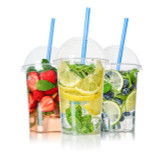A Guide to Eco-Friendly Food Packaging Choices
The growing consciousness of environmental friendliness led to many innovations in the advanced world. Everyone has started to make eco-friendly choices. You can see that almost every industry has a different product range labelled with an “environment-friendly” tag.
With this increasing popularity of green choices, companies have started investing in sustainable food packaging solutions. We are going to discuss these eco-friendly packaging alternatives that the food packaging industry is moving towards.
There are so many types of sustainable packaging options that we are going to discuss today. After knowing all these packaging types you will begin to see your food’s packaging differently.
What is Sustainable Packaging?
Sustainable packaging is the type of packaging that is used to reduce environmental footprints on our planet and keep it safe. This packaging is done by keeping in mind the 3 R’s: Reuse, Reduce, and Recycle. You might be familiar with this concept, right?
Anyway, let us tell you this in short. Reuse means using the packaging multiple times, Reduce means reducing the use of harmful packaging materials, and Recycle means recycling the packaging material.
There are other names for sustainable packaging such as green packaging, recyclable packaging, biodegradable packaging, eco-friendly packaging, etc. All these packagings help keep the environment clean and the planet safe.
What are Sustainable Food Packaging Solutions?
The best food packaging options depend on factors such as the type of food, how it will be transported, and the desired environmental impact. Here's a breakdown of the best packaging choices based on different food types and needs:
1. Metals (Cans, Boxes, and Containers)
- Best For: Canned foods (soups, vegetables, fruits), sauces, and long-lasting shelf-stable products.
- Benefits: Metal is rigid and long-lasting, offering excellent protection against moisture, light, and air, which helps preserve the quality and freshness of food. It is also recyclable, making it a sustainable option.
2. Plastic (Including PET)
- Best For: Takeout, delivery, and cold foods.
- Benefits: Lightweight, durable, and versatile, plastic is widely used for takeout containers and delivery packaging. However, PET plastic is not suitable for hot food but works well for salads, cold dishes, and beverages.
- Environmental Consideration: Opt for recyclable plastics or PCR plastic (Post-Consumer Recycled plastic) to reduce the environmental impact.
3. Aluminium
- Best For: Hot food, cooking, and freezing.
- Benefits: Aluminium is highly resistant to heat, making it ideal for foods that require cooking or reheating. It preserves the quality of food and can withstand high temperatures. It's also a recyclable material, which adds to its sustainability.
4. Vacuum-Sealed Pouches or Compostable Trays
- Best For: Fresh produce, meats, and foods prone to spoilage.
- Benefits: These packaging options help maintain freshness and prevent spoilage by sealing out air and moisture. Compostable trays are an excellent option for reducing environmental impact, making them ideal for businesses focused on sustainability.
5. PCR Plastic Bottles or Aluminum Cans
- Best For: Beverages (water, soft drinks, juices).
- Benefits: These materials are ideal for protecting liquids from external elements and ensuring long shelf life. PCR plastic reduces waste by using recycled materials, while aluminum cans are fully recyclable.
6. Corrugated Boxes
- Best For: Transporting bulk items or fragile foods.
- Benefits: Corrugated boxes are lightweight, strong, and easy to recycle. They are often used for shipping food items and can be customized for branding with logos and product information.
7. Folding Cartons
- Best For:Frozen foods, chilled items, and confectionery.
- Benefits: These are versatile and commonly used for packaging frozen meals, desserts, or confectionary items. They offer good protection and can be printed with branding to reinforce brand identity.
8. Rigid Boxes
- Best For:Luxury foods and gift packaging.
- Benefits: Rigid boxes offer a premium unboxing experience and are often used for high-end products or gourmet food gifts. They provide maximum protection and can be elegantly designed.
9. Biodegradable Straws and Stirrers
- Best For: Beverage packaging.
- Benefits: Made from materials like paper, PLA, or avocado seeds, these biodegradable options are ideal for businesses looking to eliminate single-use plastic. They are eco-friendly and help reduce the environmental impact.
10. Brand Reinforcement with Packaging
- Best For: All types of food packaging.
- Benefits: Packaging isn't just about functionality; it can also serve as a tool to reinforce your brand identity. You can use design elements, colors, and messaging that reflect your brand's character, making it memorable to customers.
Conclusion:
The best packaging choice for your business will depend on the type of food you’re selling, its transportation requirements, and your commitment to sustainability. For hot foods, aluminium containers or corrugated boxes may be the best choice, while PET plastic or folding cartons work well for cold items. If sustainability is a priority, compostable trays or biodegradable packaging options like bagasse or PLA are excellent choices.
Recent Posts
-
Impact of Disposable Coffee Cups and Lids
The Environmental Impact of Disposable Coffee Cups In today's fast-paced world, grabbing a coffee on …29th Jun 2025 -
Clear PET Cups: The Best Choice for Takeaway Drinks
Why Clear Plastic PET Cups Are Perfect for Takeaway Juice, Milkshakes, and Smoothies Clear plastic P …11th Jan 2025 -
Ultimate Guide to Paper Cups – Hot & Cold Drinks
In today's fast-paced world, paper cups are an essential part of the food and beverage industry. Whe …17th Dec 2024



